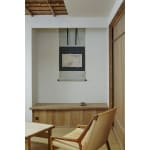Matsuo Bashō (1644–1694)
Morning Glory
Ink on paper, hanging scroll
Inscribed by the artist
With authentication by Okura Kyusui
Seal: Sei
27.8 x 42.8 cm
115 x 56 cm (overall)
Inscribed by the artist
With authentication by Okura Kyusui
Seal: Sei
27.8 x 42.8 cm
115 x 56 cm (overall)
Further images
Exhibitions
Basho: shinshutsu sakuhin o chushin ni II. Itami: Kakimori Bunko, 2016. cat. no. 1.
I am just a man, who eats breakfast with morning glories.
(Asagao ni / Ware wa meshikuu / Otoko kana)
Basho published this haiku in Minashiguri (Shriveled Chestnut), the poem collection of Basho and his disciples in 1683, and prefaced it with “In imitation of Kaku’s verse on a firefly.” “Kaku” refers to Basho’s favorite pupil Takarai Kikaku, who composed the firefly poem in reference to the Japanese proverb, “Some insects prefer to eat knotweed” (meaning, “to each his own”). Kikaku adds, “Though there is this proverb of knotweed-eating insects, I am a haikai poet who lives in a thatched hut and live like a firefly eating knotweed and flying around at night.” Basho responds that unlike his pupil, he is early to bed, early to rise, and eats breakfast quietly with the morning glories.
Basho also made an oblong hanging scroll with the same poem using similar lettering, though the painting of the morning glories consists of a vine wrapped around a stake, instead of a fence. Basho made a collaborative work with this poem, in which the artist Hanabusa Itcho (1652–1724) painted a morning glory in a cylindrical bamboo vase. Basho inscribed the verse on a small square poem card that hangs o a dangling vine. The square card is drawn with shell white pigment for Basho’s poem to be inscribed. Perhaps Itcho, who was said to have studied haikai under Basho, influenced his poetry teacher’s morning glories. The inclusion of three poems by Itcho in the above-mentioned Minashiguri reveals the close friendship between the two.
Matsuo Basho (haiku poet; 1644−1694)
Also known as Munefusa; Tosei; Hakusendo; Bashoan; etc.
Iga-born mid Edo period haiku poet. First learned the Teimon-ha style of haiku poetry composition after Kitamura Kigin, and later gained inspiration from the Danrin-ha style after moving to Edo. Through numerous travels, Basho set up the Shofu style that had elevated haiku to a form of high art.
(Asagao ni / Ware wa meshikuu / Otoko kana)
Basho published this haiku in Minashiguri (Shriveled Chestnut), the poem collection of Basho and his disciples in 1683, and prefaced it with “In imitation of Kaku’s verse on a firefly.” “Kaku” refers to Basho’s favorite pupil Takarai Kikaku, who composed the firefly poem in reference to the Japanese proverb, “Some insects prefer to eat knotweed” (meaning, “to each his own”). Kikaku adds, “Though there is this proverb of knotweed-eating insects, I am a haikai poet who lives in a thatched hut and live like a firefly eating knotweed and flying around at night.” Basho responds that unlike his pupil, he is early to bed, early to rise, and eats breakfast quietly with the morning glories.
Basho also made an oblong hanging scroll with the same poem using similar lettering, though the painting of the morning glories consists of a vine wrapped around a stake, instead of a fence. Basho made a collaborative work with this poem, in which the artist Hanabusa Itcho (1652–1724) painted a morning glory in a cylindrical bamboo vase. Basho inscribed the verse on a small square poem card that hangs o a dangling vine. The square card is drawn with shell white pigment for Basho’s poem to be inscribed. Perhaps Itcho, who was said to have studied haikai under Basho, influenced his poetry teacher’s morning glories. The inclusion of three poems by Itcho in the above-mentioned Minashiguri reveals the close friendship between the two.
Matsuo Basho (haiku poet; 1644−1694)
Also known as Munefusa; Tosei; Hakusendo; Bashoan; etc.
Iga-born mid Edo period haiku poet. First learned the Teimon-ha style of haiku poetry composition after Kitamura Kigin, and later gained inspiration from the Danrin-ha style after moving to Edo. Through numerous travels, Basho set up the Shofu style that had elevated haiku to a form of high art.







